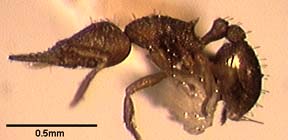Strumigenys eggersi Emery 1890
Dacetonini, Formicidae, Hymenoptera, Insecta, Arthropoda, Animalia
John T. Longino, The Evergreen State College, Olympia WA 98505
USA.
longinoj@evergreen.edu
16 April 1997

Specimen: Costa Rica, Prov. Guanacaste: La Pacifica (J. Longino 530-s). INBIOCRI001283813. Image by J. Longino. 
Contrasting presence of spongiform appendages between gundlachi and eggersi. Drawing based on Brown (1960).
Identification
Apical fork of mandible small, with two tiny intercalary denticles (figure above); mandibles straight, with weakly convex inner borders, each bearing 4-8 minute denticles on distal 1/3 to 1/2; spongiform appendages of petiole and postpetiole obsolete; first gastral tergum superficially reticulate-punctulate and opaque in front, becoming indefinitely shagreened and weakly shining behind.
Head length 0.39-0.47mm, mandible length 0.22-0.27, CI 83-88, MI 56-64 (n=32 workers from 22 localities; Brown 1962).
Similar species: gundlachi, subedentata, trieces.
|

Specimen: Costa Rica, Prov. Guanacaste: La Pacifica (J. Longino 530-s). INBIOCRI001283813. Image by J. Longino. 
Face view of worker and, magnified at lower right, anterior view of apical fork of mandible. Drawing based on Brown (1960, 1962). |
Range
Throughout mainland tropical America from southern Brazil to southern Mexico, and on many Caribbean islands. Costa Rica: Atlantic and northern Pacific lowlands (possibly exotic; see below).
Natural History
Brown and Wilson (1959) summarize the genus as follows:
"Widespread in tropics and warm temperate areas. Primarily forest-dwelling; some species occur in grassland and arid scrub. ... Nests mostly in soil and rotting wood; a few species live in arboreal plant cavities in tropical rain forest. Foraging hypogaeic to epigaeic-arboreal. Food: most species are collembolan feeders; a few are polyphagous predators or occasionally feed on sugary substances..."
For S. eggersi, Brown (1960) reported
"Weber found specimens in a compost heap in the Botanical Garden at Roseau, Dominica, and in an island of vegetation growing in the Pitch Lake of Trinidad; also on Trinidad, he took a sample from low-growing epiphytes in second-growth forest. Kempf sifted specimens from humus in Sao Paulo. Indications are that this species can stand more dryness than many dacetines, and its presence in many culture areas suggests that it is spreading rapidly through nursery stock transport and other human commerce."
He suggested that southern Brazil and Bolivia was its home range, and that elsewhere it had been introduced.
In Costa Rica this species appears rare, although my collecting has not emphasized dry and/or synanthropic habitats.
Selected Records
Winkler samples from Finca La Pacifica (riparian forest in seasonally dry region), La Selva (lowland rainforest).
Literature Cited
Brown, W. L., Jr. 1960 (1959). The neotropical species of the ant genus Strumigenys Fr. Smith: Group of gundlachi (Roger). Psyche 66:37-52.
Brown, W. L., Jr. 1962. The neotropical species of the ant genus Strumigenys Fr. Smith: Synopsis and keys to the species. Psyche 69:238-267.
Brown, W. L., Jr., Wilson, E. O. 1959. The evolution of the dacetine ants. Quarterly Review of Biology 34:278-294.
 Go back to top
Go back to top



